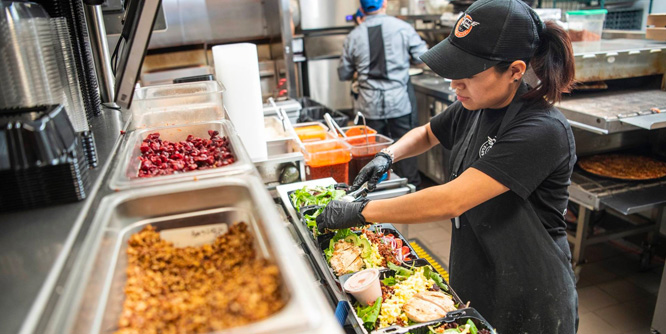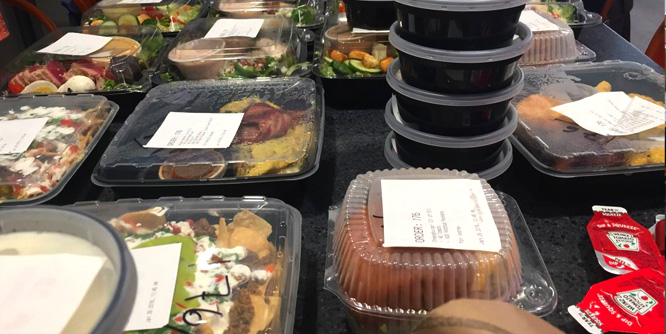
Photo: Clustertruck
Will Kroger’s dark kitchens cook up something good?
When customers order pre-made meals from Kroger in the future, the food that shows up at their door might not have ever seen the inside of an operation owned by the nation’s largest supermarket operator. But if the hype about dark kitchens is true, the orders should get there lightning fast.
Kroger announced that it would begin piloting the use of dark kitchens to facilitate faster food delivery with a service called Kroger Delivery Kitchen in three urban and suburban U.S. markets. The vendor responsible for the enabling technology, ClusterTruck, has been in operation since 2016 with its own menu and purports to be able to get food to customers within 30 minutes of its being ordered and seven minutes of the completion of its preparation. Kroger Delivery Kitchen will offer customers multiple menus of food selections and will not have any service or delivery fees attached.
Grocers and foodservice retailers have been experimenting with dark kitchens (also known as “scratch kitchens” and “cloud kitchens”) as customer demand for both fresh pre-made food and fast home delivery created new challenges. The off-site food preparation facilities are usually located in industrial areas, and don’t serve dine-in customers. Retailers typically rent the facilities so they do not absorb the overhead of owning their own kitchens. They are often shared between multiple retailers, all preparing their own menus.
The concept of dark kitchens has been picking up, not only with retailers that sell food, but also with big names in the food delivery space.

For instance, a co-founder of rideshare/delivery startup Uber has gotten into the dark kitchen space, according to Financial Times, and tech giant Google is backing a cloud kitchen startup, which provides in-kitchen services and access to order processing solutions for a monthly fee.
In the U.K., numerous restaurants have already used shared cloud kitchen relationships with startups like Deliveroo Editions as a way to expand their footprint without opening new locations, BBC reports.
- Kroger Launches Dark Kitchen Partnership with ClusterTruck in Columbus, Denver and Indianapolis – Kroger/PRNewswire
- Are cloud kitchens the next evolution of food delivery? – RetailWire
- The start-ups building ‘dark kitchens’ for Uber Eats and Deliveroo – Financial Times
- Does your dinner come from a ‘dark kitchen’? – BBC
Discussion Questions
DISCUSSION QUESTIONS: What do you see as the biggest opportunities and challenges facing retailers like Kroger that are experimenting with dark kitchens for home food delivery? What will determine the eventual success or failure of Kroger’s dark kitchen pilot?


Seems like a winning idea and the shared facilities makes it more economical to operate. I think the time frame sounds somewhat unrealistic but if the delivery speed is close to the times that they tout, then more power to them. I think the challenge will be the plastic containers that all this food is delivered in. Yes some people recycle, but it will become an issue in the long run unless Kroger and others start to deal with the paper and plastic waste.
Consumers’ busy schedules and demand for convenience have propelled a significant increase in pre-made meals and home delivery. This increase has put a strain on in-store production and juggling in-store orders with home delivery orders is a challenge. Dark kitchens are a viable option if the demand can justify the added investment. On the positive side, the cost per square foot can be much less expensive as it can be located in a lower cost area.
Several grocers and fast food companies are experimenting with this model and sharing a space with other companies and sharing delivery drivers may be a more cost effective approach.
This is a very interesting space and could be a game changer. There are kitchens that specialize in catering and office cafeterias that are a natural fit. It opens up amateur chefs in the neighborhoods. For households it is not just convenience but the tastes/menu that they don’t get in standard takeout menus from known restaurants. The most obvious complexity and cost lies in the last-mile logistics to meet delivery within 30 minutes.
Dark or “ghost” kitchens are the future not only for grocery, but for fast food restaurants as well. The benefits have mostly to do with the ability to deliver not only to stores but also directly to the consumer from a central facility that costs less, is built for pickup only (rather than shopping) and is staffed by associates that are experts at food. Also, with a large chunk of change going to third parties for delivery now, the “dark” kitchens should alleviate much of that cost — or at least that’s the plan.
From a pure grocery standpoint speed and expertise are also the upside, but how well the goods travel is the potential limiting factor/downside. P.S.: H-E-B is well down the road on this idea and it sure looks to me like it is working.
Part of the equation is how much the consumer knows about where the food they order is prepared. If I order a meal from Kroger I assume that food to was prepared at a Kroger store or facility. My grocer, for example, proudly posts signs that the baked goods and prepared foods offered in its stores are made onsite. That being the case I would assume any meal ordered from them would be, too.
Obviously, Kroger and others that use these facilities want to deliver their customers a wonderful meal; here’s where it gets complicated. These days we like to know where and how the products we buy are made, and where they are sourced. Dark kitchens are necessary for programs like this to succeed, but I believe consumers need to be in on the details.
It makes total sense, maybe it would even work to turn to existing commercial kitchens that are busy during the day and vacant at night for more cost savings. There’s more than a bit of a “wag the dog” possibility here. With the right digital advertising, social media, and properly “influenced” reviews, it’s easy to see how a new non-existent neighborhood restaurant could become an acclaimed and award winning digital star.
I see dark kitchens as a game changer in the quickly shifting landscape of prepared foods. Blue Apron and the like need to be prepared for disruption a la taxis from Uber and Lyft. This is a good move by Kroger but they need to be vigilant on quality. Nothing kills a good program or a restaurant faster than a bad meal.
I love the dark kitchen concept. Almost no one actually eats in the restaurants that I pick up lunch from in midtown Manhattan but those restaurants are paying very expensive midtown Manhattan street level retail rents. I see this as a metaphor for the broader retail sector, which continues to carry all the costs of legacy brick-and-mortar businesses in addition to the incremental costs that e-commerce adds.
Unless you are Wegmans, why would a supermarket want to prepare meals for delivery in every store? That is far from their core competence. The “dark kitchen” solves that problem. Having someone else do what they do better than you is a basic business principle. The challenge is quality. Will the program get so big that Kroger can no longer control the quality of the product (if it matters)?
The long term impact may be that these dark kitchens become consumer businesses themselves. But if they do, there really is no downside to Kroger or any others who use them.
There are several potential wins from food retailers employing dark kitchens: First, a dark kitchen can be operated as a restaurant kitchen as opposed to a meal preparation facility in the store (normally adjacent to the deli). Second, the issues of food quality, chef preparation, fresh ingredients, innovative menus, etc. can be more focused in a standalone dark kitchen. Third, as noted, the speed to market (namely delivery) is supposedly enhanced via this method of meal preparation and delivery.
Some potential issues: Food has to be excellent and hot or ready to heat. Menus and preparation need to reflect meals that will be prepared in advance and then delivered (this is not the same as the meal in your favorite restaurant). Likewise, packaging needs to be on-brand with a perceived chef-prepared meal, namely, no Styrofoam here.
Obviously this idea is working, but I can’t help but feel like it misses the point. I thought the idea was to leverage the existing investment in stores. I guess demand outgrew capacity…